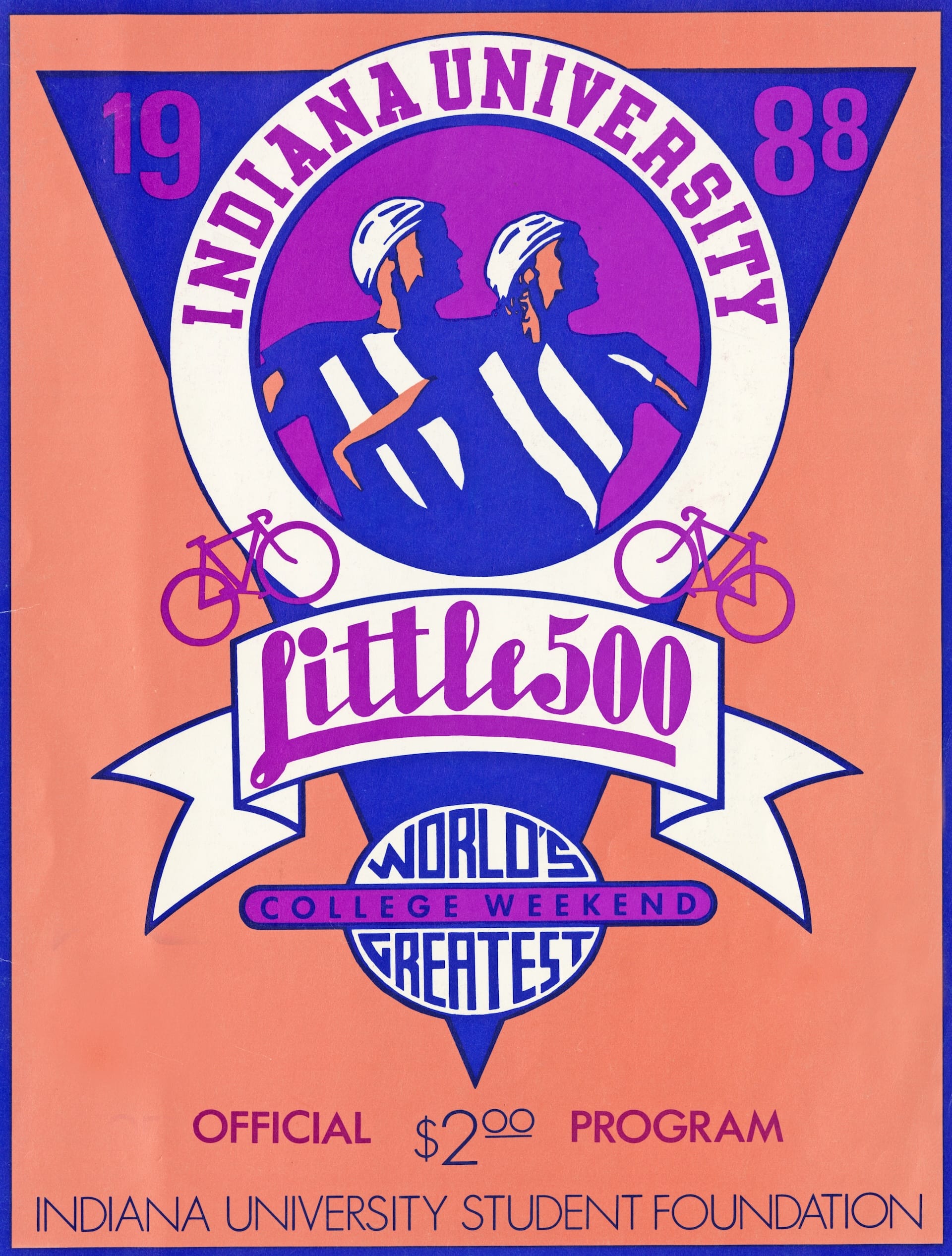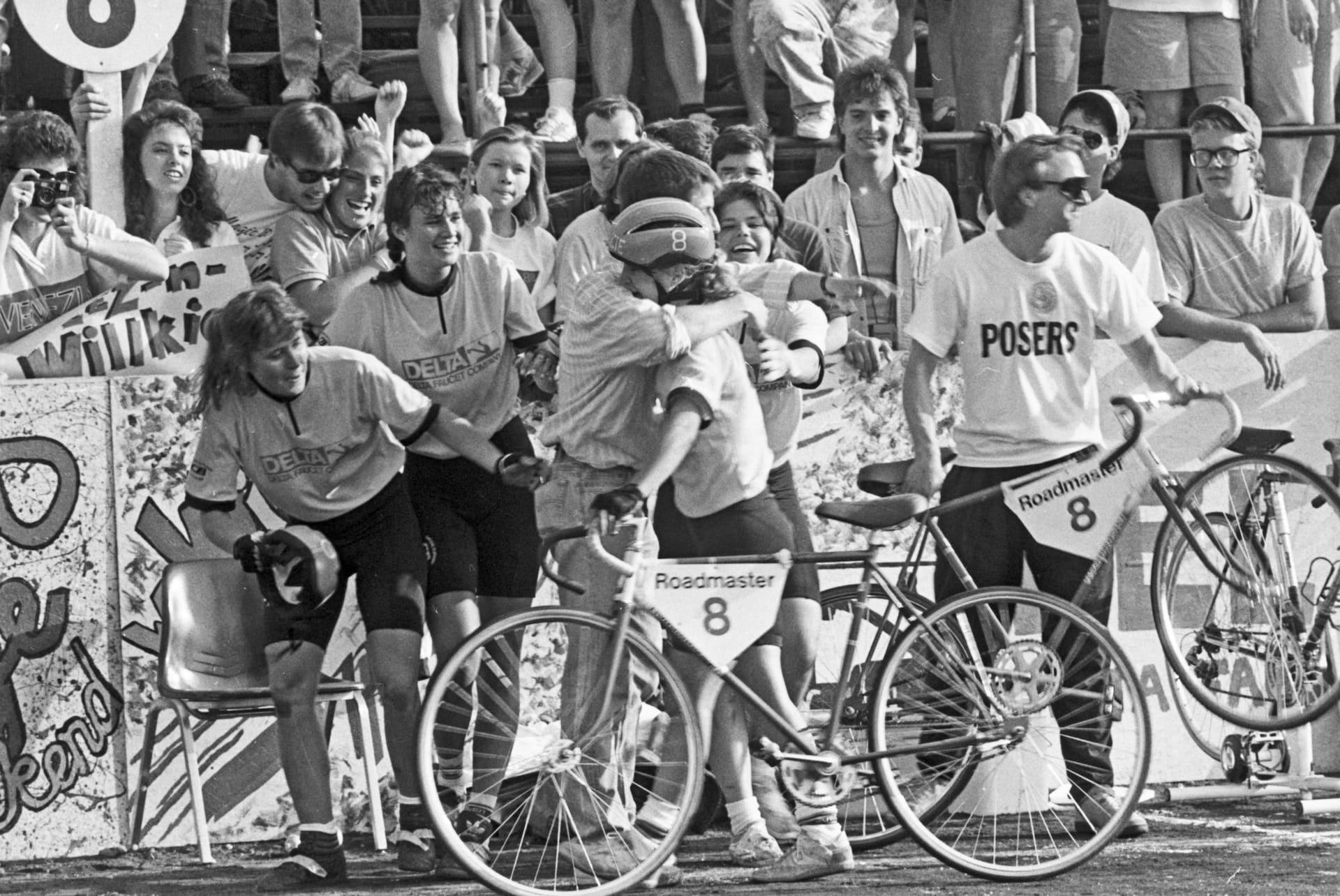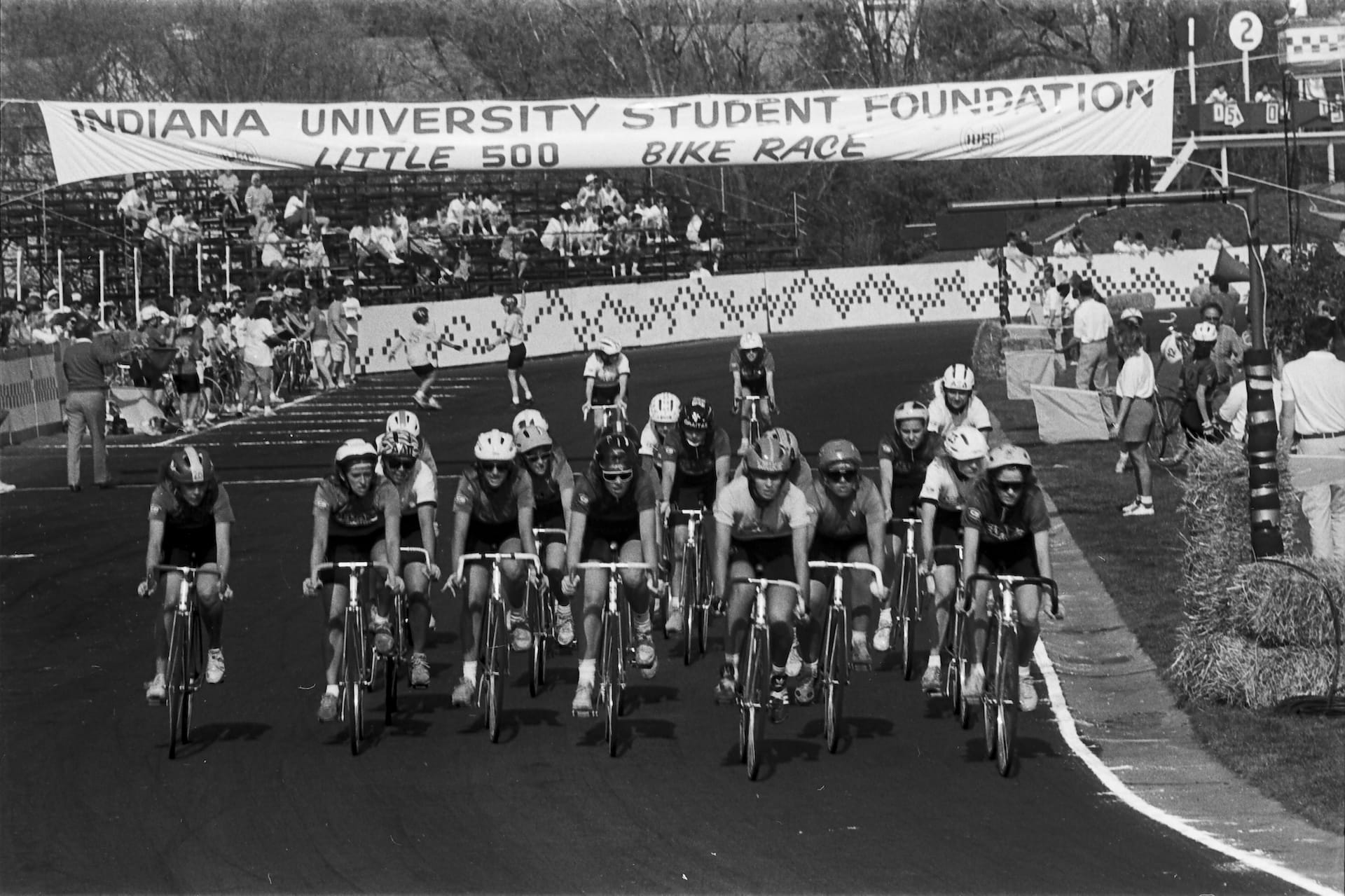From its inception in 1951, the race was men only, although Hellmuth writes that female students were “thrown a bone” in 1955 with the creation of the "absurd and incredibly sexist" Mini 500, in which female students competed on large tricycles. Female students eventually fought for their own race. In 1988, as federal laws on gender equity in sports and education were slowly taking hold on college campuses nationwide, IU created the first-ever women's Little 500, which Hellmuth and a team of fellow freshmen at IU would win. Hellmuth went on to race professionally, including in both the women’s Tour de France (then called the Grand Boucle Féminine) and Giro d’Italia. She now lives in Trento, Italy with her two beloved sons Gino and Giorgio. This year's Little 500 takes place this week, April 25 for the women and April 26 for the men.
The week before the Little 500 itself, we had Team Pursuit, the final race of the Little 500 Series. It was an important opportunity to see how Willkie Sprint stacked up as a team, just six days before the big day, the first ever women’s Little 500. Team Pursuit was raced as team versus team. We had to draw on our experience with riding in a paceline.
“OK. This is it,” said our coach, Kevin Wentz, as we prepared to head over to the track. “You have one shot to make the finals. Ten laps, all out. We are racing against whatever opponent they assign us but also against the clock. The two fastest teams – only the two fastest teams – make it to the finals.”
“No matter who you are paired with,” added our teammate and co-coach Kristin McArdle, “you have to race your little legs off to get one of the top two times if you want to make the finals. They record everyone’s times, and the fastest two advance to the championship match where they race for the win.” She looked at us intently.
“I know we can make it if everyone is on,” said Kristin, “but remember the time trial out at Morgan-Monroe State Forest?” How could we forget the collective emotional break-down during our practice run – that sweaty moment of frustration, cursing and tears – that forced us to solidify, shoring up our messy paceline and racing as a unified streak of red, no rider more important than the next? “Remember what we learned out there? Teamwork is everything. It’ll be the same thing on race day. Take care of each other. The team time is based on when the third rider’s wheel crosses the finish line. Use all four riders as long as you can. Louise, pull hard early.”
“You’ve got this, girls. Been training for it all year,” said Kevin. “Now let’s get over to the track. Do a few hard efforts on your ride over there to warm up.” We headed out, wearing our team jackets with our matching Willkie Sprint T-shirts underneath. We chatted, joked, and sprinted against one another up all the rises on our way to the track.
Pedaling up the entrance drive from Fee Lane to the Bill Armstrong Stadium, we made our final effort, passing by other riders and teams who had not chosen to sprint up the long hill. They had more oxygen available for speaking, made clear by their cheers, cajoling, and catcalls to us as we zoomed past.
“Save a little for the race!”
“Guess who is gunning to win today?”
“Kirsten’s beating you, Kerry!”
“Nice legs, you get those riding?”
“Hup! Hup! Hup!”
“Looking good, good-lookin’!”
Compliments and insults were hurled our way as we barreled up the climb to the track. The members of the other teams had been our companions for months at the track. During that time, we had learned track skills, perfected our exchanges, and shared laughs. We were united in participating in a first for female students, in training hard day after day, and in dreaming of pulling off the win. Together, we had gone from being total rookies to new cyclists to competitors. The camaraderie that we had enjoyed at Bill Armstrong Stadium every day over the previous six weeks was an unexpected bonus of competing in the Little 500. Riding in endless circles on cinder together, the hundred-plus female riders comforted each other after our falls, bantered endlessly, and puffed our chests out. We had become friends. Some were better or closer friends than others, yes. But if I saw anyone I recognized from the track on campus, I always took the time to greet her, maybe asking how things were going or whether she would be at the track later.
Only one team would win the Team Pursuit that day. Only one team would win the inaugural Little 500 race six days later. Regardless of whoever actually won, the real point was that we had all won in a sense, just by participating. We were all part of making the first year of the women’s race successful. Together, our dedication to training and love of the Little 500 experience had proven that women deserved to be given the same opportunities as men. The riders of the inaugural race had grabbed hold of the equal opportunity and gotten maximum benefit from what the Little 500 offered. The Kappa Alpha Thetas and the host of women fighting prior to and alongside them, well, it turns out they were right. The friendships within and between teams were both an added bonus and the most poignant part of the experience.
“Did you hear all the grief I took?” said my teammate Kirsten Swanson after we caught our breath.
“Sue yelled out, ‘Your shoelaces are caught in your chainring!’ No respect, I tell you.”
I told her that the comments got worse after she passed and that no one was spared.
“Serves us right, I guess, for racing by everyone,” I said, because it did. “We probably looked so cocky.”
“Well, it worked,” said my teammate Louise Elder. “I am totally warmed up now. Can’t do any more of that sprinting stuff till we are in the race, or I won’t have any energy left!”
“Yup, that’s it,” said Amy Tucker, our other teammate. “In fact, we can just skip the race. I got my warm-up and workout in, all at once. Game over, folks. We can just ride back to the dorm if you guys are ready.”
“It is definitely no fun riding these track bikes on any sort of incline,” I said, feeling happy to have arrived at the flat ground of the track. Chatting away, we jumped on the track and rode some more warm-up laps.

Luckily we had drawn an early heat. The Team Pursuit race pits one team against another in a 10-lap race. Teams are randomly paired. Each team lays their bikes on the track, exactly opposite one another in the first and third corners. The teams must then stand 20 feet away from where their bikes lay. When the IUSF official fires the starting gun, bam!, both teams run to their bicycles, mount them, and take off on their 10-lap race.
“Kevin and I will each be standing on the infield,” said Kristin as we waited our turn, watching the first heat. Two sorority teams were racing, one slowly advancing toward the other. We heard the riders of one team shouting at each other as they passed. “Leave the yelling to us when you are out there. We’ll be in opposite corners shouting at you. Kev’ll be giving you splits.”
“Hopefully you’ll be giving us encouragement, not just shouting,” said Louise.
“No, no, shout at us! Tell me to get my fat ass moving,” said Kirsten, and we all shared a laugh. As she was not much more than skin and bones, that was the last comment that anyone would lob her way.
“I’ll leave that to Kevin,” said Kristin. “I’m just giving love and encouragement.”
“Listen,” said Kevin, “this race is the one that shows which teams have the depth to be competitive on race day. I am hoping to see you guys catch the sorority by the tenth lap. Just make that your goal.” The earlier heat finished, and the riders in our heat were instructed to take the track.
“Finally,” said Amy, as we lined the bikes up in the order that we had agreed on for starting our paceline. “I am ready to get this over with.”
“Me too,” I said. “Let me know right away if anyone comes off our paceline. Should we just agree to shout out ‘off’ if it happens?” We agreed and headed to the infield to hear our race instructions.
“This is a race against the clock,” said the IUSF official. “You will have another team racing at the same time, and most will work to catch them. But, remember, the only thing that advances you to the championship race is your time. Got that? Race against the clock, then. You’re gonna start at the chalked line on the infield. No one moves till I fire the starting gun in the middle. Questions? If not, let’s go.”
“Race against the clock, then, is it?” I said, mimicking the official as we walked to our start line. I looked at the others and saw that everyone had their game faces on. Time to get serious. “Let’s do this,” I said. With that, we stood, a bit crouched like sprinters, ready to go. We watched the official raise his start gun, and bam! We were off!
I sprinted so hard to my bike that I nearly skidded on the cinders and fell when I reached it. Now, go! I told myself as we all hopped on our bikes and jammed on the pedals to get up to speed. I fell into line second as was our plan. No one immediately shouted “Off,” meaning we had managed to get up to speed together. From there, the goal was simple: to keep it rolling as fast as possible, rotating through at the front of the paceline as smoothly as possible. For once, we managed to do just that.
As we snaked around the track, we started to catch glimpses of the other team in the far corners as we entered the straightaways. The carrot always draws the horse, and we sped up, trying to reel them in. I went into hyperfocus, that zone where time seems to slow down, the current effort is all that exists, and you are only minimally aware of your surroundings. Suddenly, the other team was right in front of us. So was the end of our tenth lap. We had caught the other team, right on the buzzer.
“Couldn’t have done any more,” said Amy, still catching her breath as she cruised up to me on our warm-down lap. We rolled to a stop next to Kevin and Kristin and regrouped with the others.
“Fastest time so far today,” said Kevin. “Nice job. Now we can sit and watch people try to beat it.”
“With our fingers crossed,” Louise said. “I am still shaking from that effort.” I was too.
“Now I know what they mean when they say you’re in the zone,” I said. “I was super focused, like nothing else existed.”
“Well, that’s how you need to be on race day,” said Kirsten. “Your last pull was breaking my legs to stay on. Helps that you’re so dang tall and have that huge draft – that’s the zone I was loving.” I had heard that comment before. Everyone loved riding behind me because I blocked all the wind so thoroughly with my 5’10” height.

Kristin had brought some blankets, and we sat in the bleachers they had been building over the past month to accommodate the Little 500 crowds. I guess the stands were added every year, and they doubled the stadium’s capacity by replicating the size of the permanent structure on the opposite side. As we watched their construction during track practice, I did wonder if they would actually fill all that seating. It seemed that darn near every student would need to come to fill all those seats. That day during Team Pursuit, they were relatively empty. The only pre-Little 500 race to draw much of a crowd had been Qualifications. Sitting up in the new bleachers, we hung out watching to see if we made the finals from behind our pit on the backstretch. Once in a while, we’d yell some encouragement to friends from other teams as they zoomed by.
“OK, you guys better go take a little spin and get your legs warmed up again,” said Kevin when it looked like no one would knock us out of contention for the championship race. We went as far as the large parking lot at the IU Memorial (football) Stadium down below, where we rode around in circles for a while.
“It’s you guys versus Notorious,” said Kristin, who had descended on her bike to find us. “The finals are in 20 minutes. Come on, we better get back up to the track.” We had gone faster for 10 laps than anyone else, but Notorious had essentially equaled our time. Now we would race them, team versus team in the finals. Objectively, we had done well in all the Little 500 Series races but had not won any of them. This was our last chance. Only today’s race, the finals of Team Pursuit, remained before Little 500 race day. The Thetas had placed fifth, so they were out, much to our relief. This time, I was nervous. We all were. It was the championship match. Notorious had some strong cyclists. As we lined up, crouched and waiting for the starting gun, I noticed my right leg shaking a little bit. Was I nervous or cold? Both. Ten laps, I told myself, only 10. Get in the zone.
Bam! The starting gun launched us into action. Once we were up and riding, we pulled unevenly, each of us trying to push powerfully at the front but gauging our teammates’ abilities to stay on the pace differently.
“Off!” Kirsten shouted four laps in, and then again, “Louise is off!” Our plan was to let whoever was lagging fall off the back eventually since the team’s time was calculated based on the third rider. But was four laps in too early? I was at the front and slowed a touch. Louise fought back on to the wheel. When I dropped off the front, rotating to the back of the paceline, I jumped into the gap that had opened between her and Kirsten, making it easier for her to stay on. Amy’s pace was fierce, and both Louise and I fought to stay on the tail end of our paceline.
I was hoping to enter the zone that I had found in our earlier heat but felt like this attempt was awkward. I was unable to manage the same degree of focus and concentration. I rode too hard at the front, dropping my teammates, and then due to making such an effort, struggled to reenter the rear of the paceline. We dropped Louise. I felt that it was my fault. I ruminated but tried to stay present and in the race. And so it went. Just keep pedaling hard, I told myself, trying to get in a rhythm that never arrived.
Kirsten, Amy, and I crossed the finish line, each making a final sprint that almost brought us parallel with one another.
“Aiiiye!” Kirsten yelled as we passed the line. I looked up from my sprint, searching for Notorious to see if they had finished yet. I thought I saw them finishing just then. A few seconds after we had. So we had . . . won? I glanced ahead and down the track as we completed the turn and saw Kevin, standing still at the end of the straightaway with both arms raised over his head. We had pulled it off. A win!

As we caught our breath, we let out some squeals of excitement.
“I felt horrible,” I said. “I felt like I never got in a rhythm. I couldn’t concentrate. I was all jerky.” I was letting loose a rapid-fire list of apologies.
“What are you talking about?” Kirsten stopped me. “We won! It might not have been pretty, but we did it.” She laughed, and I did too. We were riding a few warm-down laps. Louise caught up with us, apologizing like I had.
Kirsten stopped her as well.
“Jeez,” she said. “We did it! We did fine. You guys are so hard on yourselves.” Those were ironic words coming from the teammate who was perhaps hardest of all on herself. Kirsten wore her heart on her sleeve. If she was relaxed, finally happy with our effort and first-place finish, then we all should be.
“More than fine, Kirsten,” said Amy. “We won! And all I could think during the whole race was, I never had to pee so bad. I think it’s all that water I drank. Kirsten, you got me so worried about staying hydrated.” Smiles won over our facial expressions. As the Notorious team members approached, we congratulated them and told them that having to pee was our secret weapon.
“You know, you’re lucky you were born when you were,” Dad said after we had watched the Cutters win the men’s Little 500 the following week. “Your timing here was perfect, after Title IX has really gone into effect.” I had heard of Title IX but was not really sure what it was. But my dad is an encyclopedia – and was also a career university dean with a love for all, but particularly college, sports. For a while, he even served on the Athletic Board at University of Wisconsin.
“See, in the 1970s,” he said, “they passed this law saying no one could be excluded from any educational program or activity, like sports, at any institution receiving federal funding. Well, that includes all big universities. Took ’em a while to figure out how to apply the law, because it was buried in some civil rights legislation. Eventually Title IX, which was actually just one sentence, was interpreted to mean that there had to be the same number of participants in sports for both genders and the same number of scholarships given to men and women.” Dad displayed a look of surprise, reflecting how the university sporting programs must have felt at the time. “The same numbers! After all those years of not even having women’s teams.
“I mean, hey, Title IX was a really big deal,” he said. “Still is. It’s created all sorts of problems for universities – they’ve had to balance out the number of spots in sports like wrestling and football, where there were no women’s teams, by adding programs for women. Same for scholarships. The UW crew team, for example, has all sorts of scholarships for women but not a single one for the guys’ team. Football takes ’em all. Can you imagine how that’s changed things?”
All the specifics of Title IX were news to me, although I had benefited enormously from the changing winds, and attitudes, toward equality of opportunity for women brought by the law. It was a correction of the historic gendered preference for men’s sports. I thought of my friend Margaret, swimming on a full scholarship at UW. She was lucky that she had not been born 10 years earlier and arrived in college before Title IX was being enforced.
But the Little 500 was different. Since it was just an intramural collegiate activity, not an NCAA sport, it was not strictly beholden to the same standard of Title IX. It took countless courageous riders and Phyllis Klotman to push the agenda of Title IX into the Little 500 arena. So again, I say my thank-yous to all of them, from Amelia Bloomer on forward.
Of course, it is not just women to whom I owe thanks. The Title IX legislation had been proposed by Indiana’s native son Senator Birch Bayh, who had written, introduced, and sponsored the bill. His son Evan Bayh happened to be gearing up a campaign for governor during my freshman year, and the elder Bayh came to Bloomington in support of the effort. I met him that year at a small Honors Division event at the Haskett House. He spoke to a group of us about the equality of rights for all genders and races. If I had known then about his efforts and that he was the founding father of the Title IX legislation, I would have thanked Birch Bayh heartily in person that day.
Reflecting on the lessons that I learned in that year of my life, my freshman year of college in which I won the first women’s Little 500 race with my Willkie Sprint teammates, I realized how much that year had brought me – friendship, laughter, love, a lifelong passion for cycling, and the great honor to have been part of pushing open a new door for women.
Did we do a good job with this story?



